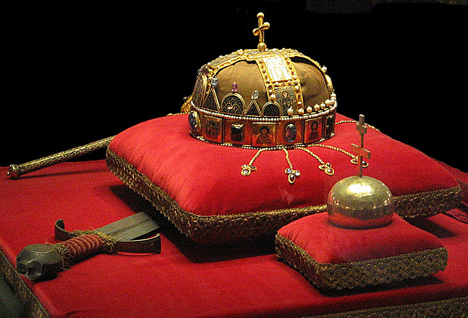When observing the ugly manifestations of extremism in Hungary or the maverick policies of its current government, foreign commentators usually perceive the underlying nationalist sentiments, but tend to interpret them as just another brand of nationalism in “New Europe”. Hungarian nationalism, however, stands out in central Europe. It is particularly forceful and, to use a mild term, nervous. It is always on the alert, wary of possible vicious attacks and lashing out when no one would expect, as there was no apparent or unprovoked offence. Ethnocentric national biases quite often override rational economic or social considerations or even, paradoxically, diplomatic interests. Moreover, the cult of national unity as opposed to pluralism is one of the main principles encoded in the new Fundamental Law (the constitution promulgated in 2011), resulting in a distortion of democratic political institutions.

Crown, Sword and Globus Cruciger of Hungary. Source:Wikipedia
It is quite difficult to understand present-day Hungarian public affairs without being familiar with the particular nature of Hungarian nationalism, while it is impossible to understand its nature without knowing its centuries-old historical roots.
The curse of continuity
One important feature that distinguishes Hungary from all other central European nations is the continuity of its statehood. Ever since its foundation in the year 1000, apart from a single decade after 1849, there has always been a functioning Hungarian state. It is a source of pride for Hungarians even today, yet it also proved to be a curse, as the rigid social, economic and political hierarchy remained intact from the Middle Ages until 1848. Much of it survived even until 1944.
The new democracy established in 1989 was thus confronted with the following dilemma: on the one hand, the Hungarian nation-state had a singularly strong and continuous pre-communist political tradition; on the other, that tradition was essentially undemocratic. Meanwhile, there has been a series of popular freedom struggles and revolutions in the nation’s past, but they were all defeated sooner or later, so their political heritage was the spirit of revolt itself rather than any model for a viable political system.
Fidesz, which emerged as the dominant right-wing party in the late 1990s, consciously built up an image of the “great Hungarian past” out of second-hand fragments of pre-1944 ideology, while there was very little that left-wingers and liberals could set against the emotionally powerful, history-based nationalist agitation. Viktor Orbán’s first government (1998-2002) ran a huge propaganda campaign in 2000 commemorating the millennium of the Hungarian state. Symbolically, the Holy Crown of the Hungarian kings was taken from the National Museum to the Dome Hall of the Parliament. More than symbolically, a new act of legislation stated, “The Holy Crown lives on as a relic [The Hungarian word ereklye is used exclusively for religious relics] embodying the continuity and the independence of the nation in the national consciousness and in the Hungarian traditions of public law.” At that time, most people in the opposition were amused by the notion of the Holy Crown as the symbol of a secular republic. By 2011, the smiles froze: the second Orbán government forced through the Fundamental Law which reiterated the Holy Crown thesis (this doctrine being a sixteenth century invention) and dropped the word “Republic” from the official name of the country. It is now simply “Hungary”.
The preamble to this new constitution is entitled the “National Creed”, and it was admittedly modelled after the preamble of the 1997 Polish Constitution. But while the latter refers to “the best traditions of the First and Second Republics”, there is no such value-oriented selection regarding the national past in the Hungarian constitution. According to the National Creed, the same Hungarian state that was founded in 1000 and lost its “self-determination” with the arrival of German troops on 19 March 1944 was resumed on 2 May 1990 when the National Assembly was convened after the first free elections (formally putting an end to Soviet-backed communist rule).
Stressing this, one of the current government’s main projects is to reconstruct the huge city square adjacent to the Parliament “as it was on 18 March 1944”. The Hungarian state on March 18th 1944, however, was an ally of Hitler with a long record of antisemitic laws, some of which were even more radical than the Nuremberg laws. This is not to say that the Orbán government would accept Nazism; it goes to great lengths to prove the opposite. It is simply that the allegiance to an ideal unitary national community and the continuity and “self-determination” of the nation-state are the supreme values for them and for their voters rather than the components of a pluralistic liberal democracy.
Two kinds of good Hungarians
August 20th, the Catholic feast day of St. Stephen, the first king of Hungary, is an official state holiday. The central event of that day is a procession where the “Holy Right” – St. Stephen’s blackened and mummified right hand – is shown to the public. It is attended by state dignitaries of all persuasions. While the Holy Crown was created somewhat later, popular belief held that it was the very same crown that the pope sent to Saint Stephen in the year 1000. The cult of state continuity, hence, has a distinctive Catholic aspect to it. This is not the case with national or nation-state independence. As I have mentioned, there is another, rebellious nationalist tradition, which is very much – but not exclusively – associated with Protestantism. To name just one crucial event: in April 1849, the National Assembly proclaimed the dethroning of the House of Habsburg and elected Lajos Kossuth, a Lutheran, to be governor-president in the Reformed Great Church of Hungary’s greatest Calvinist centre, the city of Debrecen.
This dichotomy is older than modern nationalism. During that time when the Ottoman Turks occupied central Hungary (1541-1686), there were two Hungarian states; Royal Hungary in the west and the north, and the Principality of Transylvania in the east, with a buffer zone between the two, known as the Partium (“the Parts”) and the so-called Seven Counties in the northeast. By dynastic treaty, the Habsburgs ruled Royal Hungary, while Transylvania was more of a Polish-style commonwealth with elected princes, though under Turkish suzerainty. The Reformation was victorious in the sixteenth century, but unlike in Poland, the success of Counter-Reformation in the seventeenth century was far from complete. It was most effective in the regions closer to Vienna, while the Seven Counties and the Partium remained staunchly Protestant (with Debrecen emerging as “the Calvinist Rome”) and Transylvania was a haven of religious tolerance with a mostly Calvinist protestant majority. Although Royal Hungary was multi-ethnic and under Austrian-German rule, most of the buffer zone was homogeneously Magyar. In Transylvania, the political community was dominated by Magyars and Szeklers (an ethnic group of debated origin, given collective nobility, which many consider to be “more Hungarian than Hungarians”).
The division between the mostly Catholic west, ethnically more open and pro-Habsburg, versus the Calvinist east, which was stubbornly “true Magyar” and anti-Habsburg, remained even after the end of the Turkish occupation when Hungary was reunited. Within time, two permanent nationalistic traditions developed. Each had its own behavioural patterns, political language and traditions. Meanwhile, the tension between the lack of national sovereignty (that is, being ruled from Vienna) and the well-developed internal autonomy resulted in two more definitive features shared by both traditions. The first was an obsession with written law as the prime medium and subject matter of politics. The second feature was the emergence of a culture of grievances, as the game of home politics was mostly about detecting, and protesting against, non-Hungarian infringements upon the ancient rights and privileges of the nobility. Both are very much alive today.
A blueprint for future revolutions
More important, however, are the basic differences in political strategy between the two divisions. The conservatives held that the partial loss of sovereignty was an acceptable price for internal autonomy and building personal and national wealth. Their method of dealing with the authorities was bargain and compromise. For the rebels, any loss of sovereignty was intolerable and the lack of full national independence was seen as an obstacle to achieving national well-being. They detested compromise. While the ruling elite followed a conservative philosophy most of the time, the rebellious option has always been much more popular among the general population. I wonder if there is a Hungarian town without a Kossuth Street (the square next to the Parliament is also named after Kossuth, considered by many as the father of Hungarian democracy), while far fewer streets are named after Ferenc Deák (“The Sage of the Nation”), who was the architect of the particularly fruitful 1867 compromise.
From the seventeenth century onwards, there were revolts against the Habsburgs or, seen from another aspect, against the millennial Hungarian Kingdom under the Holy Crown. Out of these, the War of Independence (1703-11) led by Francis II Rákóczi was relatively the most successful. Rákóczi and the section of the estates that supported him, managed to set up a parallel state that existed for several years. They set the blueprint for later struggles and revolutions. Militarily, the endeavour was heroic and sometimes victorious but ultimately hopeless as it was based on foreign policy miscalculations. On the other hand, it had a democratic character compared to the region and the age (serfs were allowed to serve in the army and were promised emancipation after the end of the fights; the nobility’s traditional exemption from taxes was abolished).
The 1848-49 revolution and War of Freedom followed the same pattern, as did the 1918 revolution that was terminated by a Bolshevik coup in 1919. Except that during the democratic phase of the 1918-19 revolution there were no military victories at all, as the new government first refused and then was unable to set up a national army. So it was the communist regime’s turn to play the part of glorious losers. Foreign policy miscalculations were there all the while. Even the 1956 revolution had essentially the same positive and negative sides, and it deliberately used 1848 language and imagery. The term for the military aspect of the Rákóczi experiment, 1848 and 1956 is the same: szabadságharc, literally “freedom fight”. The Orbán government uses the very same term when it comes to its campaign against the IMF or foreign-owned public utility companies, tapping the reserves of centuries-old resentment for which non-Hungarians are the enemy and compromise is a dirty word.
Orbán and his court ideologists have never been at a loss when they had to ignore contradictions. They belong to the nationalist ruling elites that rely on popular votes. So the elitist non-republican tradition of the Holy Crown can live side-by-side with the quixotic populist tradition of the freedom fighters. The former is utilised when the main point of interest is neutralising democratic institutions and the rule of law; the latter is the main vindication for arbitrary decisions in foreign affairs and economic policy.
The Trianon trauma
Short-lived revolutionary episodes were followed by long periods of conflict-ridden but essentially peaceful evolution; the most successful of these was the age of the dualistic Austro-Hungarian Monarchy (1867-1918). It was called “the happy peaceful times” in the calamitous decades that followed. After the Compromise of 1867, Hungary found itself to be one half of a middle-ranking European power. It had its own cabinet and bicameral parliament (only foreign, monetary and military affairs were shared, although Hungary had a small home defence force of its own). It was finally reunited with Transylvania. It experienced sustained economic growth that brought it closer to western Europe. Its government was not democratic in the modern sense, as only six per cent of the people had the right to vote, but it was parliamentary and liberal. The large Jewish population, emancipated in 1867, was rapidly assimilated and ran much of industry, finances, commerce, the press and even agriculture. By the end of that period, there were Jewish cabinet ministers. It was a liberal and capitalist success story.
After 1918, all this was shattered. While for all the other central European states gaining or regaining national independence was a source of joy and self-confidence, in Hungary it coincided with the nation’s greatest historical disaster. With the Treaty of Trianon in 1920, Hungary lost 68 per cent of its population and 72 per cent of its “millennial” area, including the whole territory of present-day Slovakia, Transylvania, the Partium and Fiume (now Rijeka Croatia), its only seaport. The historical kingdom was a multi-ethnic state with a slight Hungarian-speaking majority; therefore, much of that loss was inevitable (although most of the political elites had not been aware of the danger). What made the shock unbearable was that roughly 30 per cent of ethnic Hungarians became citizens or subjects of other (hostile) states.
The ruling elites blamed the liberal “excesses”, modernising trends and Jewish over-representation for bringing about the disaster. Liberalism and urban capitalism were equated with Jews, while ethnic purity, Hungarian traditionalism and a kind of authoritarian national collectivism became uncontested values. Most of the elite saw the redistribution of Jewish wealth and a curtailment of Jewish rights as the remedy for social and economic ills. It was this popular ideology, rather than Nazi influence or pressure, which resulted in the deportation and death of the majority of Hungarian Jews within a few weeks in 1944. Also, as the western democracies had shown no intention of redeeming the injustice of Trianon to any degree, it was irredentism that drove the Hungarian political elites to Hitler’s arms (between 1938 and 1941 most Hungarian-inhabited regions were awarded back to Hungary).
Today, 94 years after the fact, the main dividing line between the left and right is still whether one “grieves Trianon” or not. This is what foreign observers seldom take into account. The Orbán government respects the post-1945 anti-racist taboos scrupulously, but apart from that, the old responses to the Trianon shock such as anti-liberalism, a suspicion of markets, statism and authoritarian national collectivism are still the attributes of the “national” side just like they were in the interwar period. It is worth keeping in mind that there is not a single liberal conservative or centre-right party in the Hungarian parliament today.
Healing the wounds of Trianon
How can the Trianon trauma be so persistent almost a century after the fact? The answer is simple: because of the communist dictatorship. First, there was hope for 25 years that the dismemberment of the country was redeemable (at least partly). After the Second World War, however, Stalin insisted on restoring the Trianon borders. When the Treaty of Paris confirmed this in 1947, Hungary was on the verge of the communist takeover. So by the time the public could have confronted the fact that the division of the Hungarian cultural nation was irreversible, there was no free public sphere where “grieving” could be done and no free international scene where the Hungarian state could or would have spoken out for the rights of Hungarian minorities. The official line was that the treaty was unjust, but it was a response to the oppressive ethnic policies of the Hungarian ruling class, while among “brotherly people’s democracies” the treatment of national minorities cannot be a problem.
Meanwhile, the népi (völkisch, narodnik) intellectuals, successors of the interwar agrarian socialist movement among writers, ethnographers and sociologists, who were the only non-communist intellectual-political cluster that was now officially tolerated, made the situation of Hungarian minorities beyond the border their central political issue. It was quietly supported by the party-state leadership, which was at loggerheads with Nicolae Ceausescu’s regime in Romania. When the process of democratisation began during the late 1980s, the Hungarian Democratic Forum (MDF), the first legalised non-communist political group, grew out of the népi movement. After the transformation, MDF occupied the niche of the largest centre-right party for some time. When the taboo on Trianon discourse was at last lifted, it was only natural that the intellectuals around MDF (who later opted for Fidesz) made it their cause.
In this respect, the referendum in 2004 about extending Hungarian citizenship to possibly all ethnic Hungarians living outside Hungary’s borders was a turning point. The initiative came from a dubious ultra-nationalist group, and Fidesz embraced it mainly for tactical reasons. The background slogan was “we can finally heal the wounds of Trianon”. The referendum failed because the socialist-liberal government of the time ran a populist counter-campaign, pretending to protect welfare achievements from poor Romanian Hungarians and people were still wary of Fidesz as they suspected that dual citizenship is just a costly ploy to gather pro-Fidesz voters abroad. This suspicion was justified later.
Afterwards, however, Fidesz made the left-wing and liberal parties and intellectuals the targets of permanent attacks for being “traitors of the national cause”. At the very first session of the new Parliament in 2010, Fidesz enacted dual citizenship, referring to the real will of the people, while the socialists, who internalised their own defamation, also voted for it with three exceptions. Ninety years after the fact, the anniversary of the Treaty of Trianon on 4 June was declared, paradoxically, the Day of National Unity. This, however, is quite characteristic of present-day mainstream Hungarian nationalism. The nation is united by the grievance of separation and one cannot be a part of that unity if one does not believe in it.







